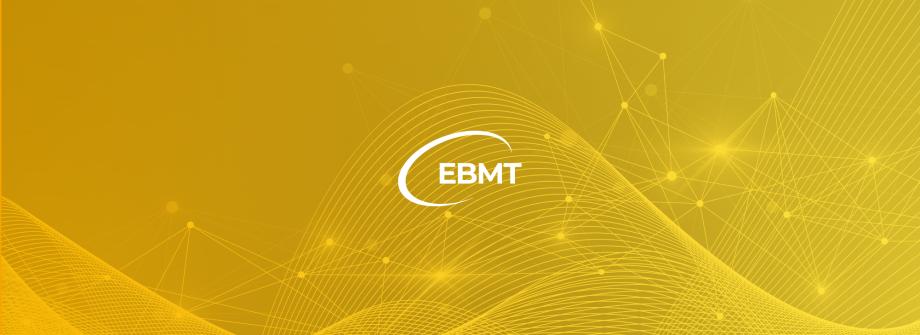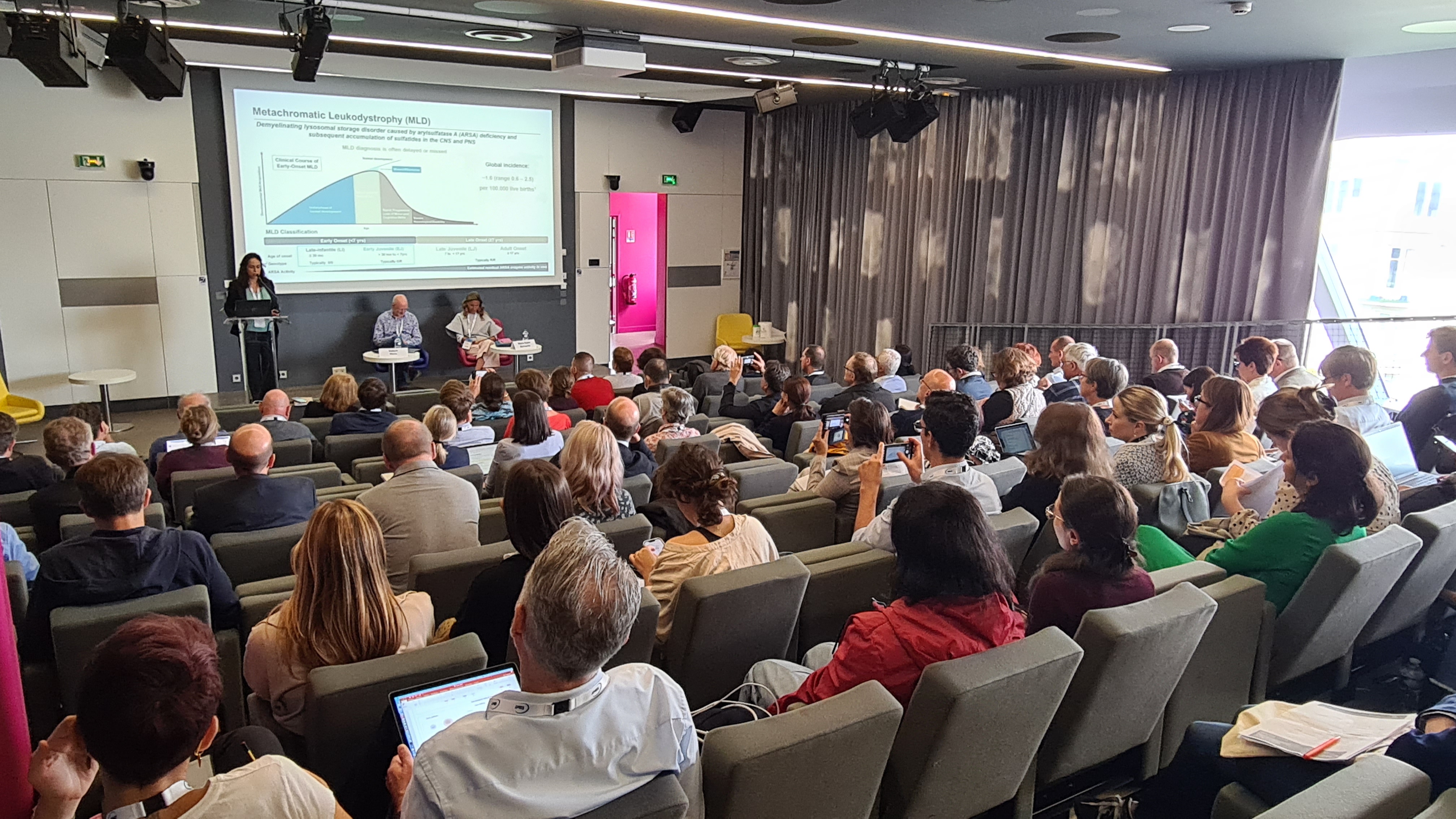
Summary by Bénédicte Neven (IEWP Chair), Michael Albert (IEWP Secretary)
The IEWP took place in Paris from 23th to 25th of September. There were 145 attendees from 25 countries. It was not only an outstanding scientific conference but also a very friendly meeting hosted in IMAGINE institute in Necker hospital.
The WP started by an opening lecture given by Alain Fischer who gave an overview of HSCT in primary Immune deficiencies (PIDs) from 1968 to 2022 and beyond.
The first session on Friday afternoon was dedicated to stem cell therapy in metabolic disorders and was chaired by Maria Ester Bernardo and Rob Wynn.
Valeria Calbi presented results from 38 patients treated by gene therapy for Metachromatic leukodystrophy (MLD) (19 late infantile (LI) and 12 early juvenile (EJ) forms) during the developement program. These were compared with a historical cohort of 31 patients. All patients achieved a sustained multilineage engraftment leading to restoration of enzyme activity at normal or supranormal levels in peripheral blood and normal levels in CSF. Severe disability was prevented in most patients in striking difference with natural history. The treatment was overall well tolerated. Based on the favorable risk benefit profile, Arsa-cel has been approved in Europe in Dec 2020 and is indicated for the treatment of LI-MLD without clinical manifestations of the disease and in Children with the EJ-MLD form, asymtomatic or with early clinical manifestations of the disease. As of Sept 2022, Five patients have been treated under compasionate use and 5 commercially with Libmeldy.
Rob Wynn shared very preliminary results on patients with mucopolysaccharidosis IIIA (Sanfilippo syndrome type A) treated by lentiviral gene therapy. This is a monocentric (Manchester) phase I-II study of autologous CD34+ haematopoietic stem cells transduced ex vivo with CD11b lentiviral vector encoding for human SGSH (OTL-201).
Maria Ester Bernardo presented some early clinical outcomes after HSPC-GT in MPSIH. The treatment showed a good safety profile. All patients showed sustained engraftment of gene-corrected cells with blood IDUA activity reaching supraphysiologic levels after GT and normal or near-normal uGAGs, maintained at last follow up (24 to 36 months). First analysis on early outcome of skeletal manifestations after GT in MPSIH were presented regarding growth, functional and radiological outcome.
Rob Wynn presented the design of a Phase I-II Study of Cryopreserved Autologous CD34+ Haematopoietic Stem Cells Transduced Ex Vivo With CD11b Lentiviral Vector Encoding For Human IDS.ApoEII In Patients With MPSII (Hunter Syndrome). The lentiviral vector has been optimized to improve uptake across the blood brain barrier. The IDS sequence of interest is fused to a tandem repeat of the receptor-binding domain of ApoE. This is driven by a myeloid-specific human CD11b promoter for enhanced myeloid expression (LV.IDS.ApoEII).
Keynote lecture given by Marina Cavazzana:
Marina Cavazzana gave a keynote lecture on issues of early immune reconstitution after HSCT and how it could be optimized. The rationale and preliminary results of a Phase I/II clinical trial of T cell progenitors injected after haploidentical transplantation for Severe Combined Immunodeficiency (SCID) were presented.
The first session on Saturday morning was dedicated to treatment of Severe Combined immunodeficiencies (SCID) and was chaired by Bénédicte Neven and Manfred Hoenig
The first part of the session was dedicated to newborn screening of SCID. Miriam van der Burg summarized pitfalls and challenges. Chris Dvorak presented the latest US experience. He showed that NBS improves overall survival of transplanted SCID. He also presented the revisited SCID definition proposed by PIDTC in 2022. These new definitions allow to better differentiate SCID from non-SCID, typical SCID, leaky/atypical SCID, and Omenn syndrome. Carsten Speckmann gave an overview of the NBS program in Germany.
The second part of the session was dedicated to late outcome of transplanted SCID. A fraction of these patients develops late complications that may benefit from a second procedure. The clinical and immunological outcome of these procedures will need to be collected to improve our knowledge. Bénédicte Neven presented late immunopathological complication occurring in transplanted SCID who developed persistent hepatitis associated with CD8 driven immunopathology and persistent chronic enteric virus infection. This condition was curable with a second HSCT or gene therapy preceded by some myeloablation.
Suk See De Ravin from the NIH, presented the approach of gene therapy as a second procedure for X-SCID, (phase I/II safety and efficacy of lentivector gene therapy in older SCID-X1 (3-40 years)). 19 patients had been treated. Arjan Lankester gave a brief update on a Phase I/II clinical trial of autologous stem cell gene therapy in RAG1-deficient SCID with preliminary results of the first patient included.
Keynote lecture given by Luigi Notarangelo:
Luigi Notarangelo gave a fascinating lecture on the Multi-omics dissection of the immunopathology of RAG defects.
Conditioning for HSCT in IEI chaired by Michael Albert and Persis Amrolia:
Optimzed and tailored conditioning regimen to avoid short and long term toxicities are key in HSCT of non-malignant diseases. A session was dedicated to this topic and started with Karl-Walter Sykora who presented the results of the phase 2 prospective, randomised trial comparing treosulfan- versus busulfan-based condioning regimen in children with non maligant diseases. Federica Achini-Gutzwiller presented the preliminary results of the ARTIC study, an exposure-response analysis of alemtuzumab in pediatric allogeneic HSCT for non-malignant diseases. Shawn Rose presented preliminary results generated in animal models using MGTA-117, a targeted and potent antibody drug conjugate being developed for treatment of AML, and which could be used for myeloablative conditioning in hematopoietic stem cell transplantation. Rajni Agarwal gave an update and new indications of a non-genotoxic Anti-CD117 conditioning (JSP191) in SCID and fanconi anemia. Eileen van der Stoep shared data on the effect of busulfan and treosulfan on gonadal function after allo HSCT in children with non-malignant diseases.
Stem cell therapy in hemoglobinopathies chaired by Franco Locatelli and Marco Zecca:
The session dedicated to hemoglobinopathies covered some aspects of the pathophysiology of thalassemia. Oliver Hermine reviewed the cause and consequences of ineffective erythopoesis and the rationale for blocking GDF-11 to promote terminal erythroblast differentiation with luspatercept. Monocentric experiences (Leiden and Roma) of haplo-identical transplants in hemoglobinopathies with PTCY and TCRab/CD19 depletion were presented by Arjan Lankester and Franco Locatelli, respectively.
Current approaches with gene therapy in hemoglobinopathies using lentiviral vector and gene editing were summarized by Franco Locatelli, while Annarita Miccio presented the perspectives of gene therapy in these diseases by base editing and prime editing.
The Saturday ended with the last session, dedicated to the ongoing studies lead by the IEWP.
Sunday morning started with a session dedicated to emerging indications chaired by Emma Morris and Andy Gennery.
Four conditions were covered during this session: X-linked agammaglobulinemia, CTLA4 deficiency, CARMIL2 deficiency and CSFR1. Andy Gennery gave an overview of the morbidity of XLA. He summarized the indications and limited experiences of transplant in this condition. Georgia Santilli presented the preliminary data on gene editing in this disease.
Mary Slatter updated data on transplantation in CTLA4 based on the limited published and unpublished experiences. It clearly showed the need to expand our knowledge in this disease to better define indication of transplant and outcome. Emma Morris presented promising results on gene editing in this condition. Romain Levy nicely presented physiopathology and clinical characteristics of CARMIL2 deficiency and summarized data on transplantation in this condition. Caroline Lindemans presented CSFR1 deficiency, a rare cause of adult onset leukodystrophy and shared the limited experience of HSCT in the Netherlands.
Sunday morning ended with a session dedicated to challenges in inflammatory conditions.
Siobhan Burns highlighted the genotype/phenotype correlation in STAT1 GOF and Carsten Speckmann summarized the preliminary results of the international survey on JAK inhibitors in this condition, including results of transplant in patients previously under JAKi. Emmanuelle Six presented the work done on hematopoietic stem cells of CGD patients treated in Necker by gene therapy. She emphasized the inflammatory profile identified in these cell populations.
Overall, the meeting again exhibited the vibrant and active research activities of IEWP, and allowed peeks into the future of cellular therapies for inborn errors of immunity, metabolism and hematopoiesis.
